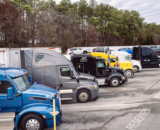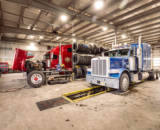The U.S. Department of Transportation (DOT) released an update to the Rural Electric Vehicle (EV) Infrastructure Toolkit, titled Charging Forward: A Toolkit for Planning and Funding Rural Electric Mobility Infrastructure.
First published in February 2022, the Rural EV Infrastructure Toolkit is designed to help rural stakeholders scope, plan, and fund EV charging infrastructure. It includes new information from the Bipartisan Infrastructure Law and the Inflation Reduction Act along with greater focus on Tribal communities and expanded content on electric transit, micromobility, and accessible design.
The toolkit highlights the critical role that truck stops and travel centers can play in building out a nationwide network of EV charging stations, calling it a “Partnership success story.”
Notably, the toolkit calls attention to the myriad market challenges that fuel retailers face as they seek to invest in electric vehicle charging stations, including utility pricing and demand charges. It also discusses the ongoing consumer concern with range anxiety.
According to the report, without outside incentive programs, the revenue from DCFC stations typically covers only about one-third of operating costs. This is largely due to utility demand charges, which are premiums charged by some utilities for using large amounts of electricity during peak hours or when high power is drawn at high rates that exceed certain thresholds.
“Since rate and demand charge structures vary greatly between utilities and across States, these costs could have substantial effects on the business case for deploying fast-charging EV infrastructure on rural corridors and in rural communities,” the report states. “Ultimately, both affordable charging rates and high station utilization are essential for station operators to earn sufficient revenue to offset the costs of purchasing, installing, and operating charging stations within a reasonable payback period (five years or less)."
The report states that the need for expanded public fast charging continues to rise with the growth of electric vehicles, especially for rural drivers, who typically drive longer distances than urban drivers and for whom existing DCFC stations are spaced much farther apart. Consumers remain concerned about the length of time it takes to charge an EV, the user-friendliness of chargers, the need to plan charging stops on long trips, and the relative convenience and safety of charging locations.
NATSO thinks that the existing nationwide network of refuleing locations represents the fastest, most efficient way to build out a safe and reliable network of EV charging stations. Fuel retailers have the locations and amenities and refueling experience that motorists have come to expect when refueling their cars.
Subscribe to Updates
NATSO provides a breadth of information created to strengthen travel plazas’ ability to meet the needs of the travelling public in an age of disruption. This includes knowledge filled blog posts, articles and publications. If you would like to receive a digest of blog post and articles directly in your inbox, please provide your name, email and the frequency of the updates you want to receive the email digest.

